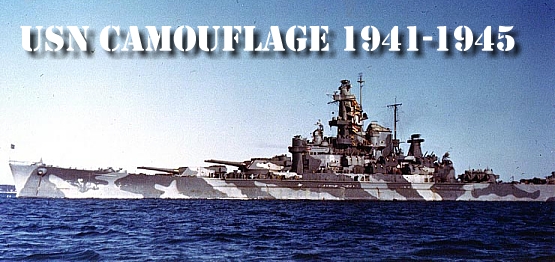
An online database of camouflage used by
United State Naval Warships during WWII
|
|
|
The
Development of Naval Camouflage 1914 - 1945 By
Alan Raven (Article reprinted courtesy of Plastic Ship Modeler Magazine issue #97/2) WAR
The
abrupt entry of America into the war on December 7, 1941 found the fleets
variously painted, but every major combat vessel wore Camouflage in one from or
another. In the Atlantic, ships
carried Measure 12A, or Measure 12R. In
the Pacific the battleships were still in Measure 1, two destroyers in Measure
1A, two in 1B, one in 1C, one in Measure 12, and a few destroyers and cruisers
carried Measure 11. The ships of
the Asiatic Fleet were painted overall in their unofficial Cavite Blue, a
camouflage type for which no measure number was ever assigned.
Coast Guard ships had long dispensed with overall white and in the
Atlantic wore Measures 1, or 12A, or 12R. The
entry into the war in the Atlantic and Pacific produced for awhile a state of
uncertainty as far as camouflage was concerned. Ships of all types were suddenly being moved around between
the commands and to different areas of operations.
Additionally many new ships, mainly destroyers, were entering service and
large numbers were undergoing refit to upgrade their anti-aircraft and
anti-submarine warfare capability. Admiral
King was promoted from C in C Atlantic to become CNO (Chief of Naval
Operations). This effectively
removed his influence on camouflage matters, which up to this point had been the
deciding and controlling factor on Atlantic Fleet vessels. The
introduction of Measure 12R, coupled with Admiral King's promotion, sowed the
seeds for a wide and sometime wild variety of Measure12R patterns to appear.
The British influence began to make itself felt, with the introduction of
an American Western Approaches camouflage, known in the USN as Measure 16.
British practice also began to permeate the Measure 12R designs, and
Mountbatten Pink was officially adopted in the Atlantic.
Also, a few WW I style course deception dazzle designs (Measure 17) were
being carried by mid-1942. The
wording of Measure 12R in respect to how the colors were to produce a broken
dividing line was confusing to some, leading to a very loose translation as to
how ships should be painted. When coupled with observation of the British
Disruptive designs this produced the widest variety of patterns.
They ranged from the smallest dapple or mottle designs such as worn by
the cruiser JUNEAU in January 1942, to the very complicated patterns such as
seen on the destroyer FARENHOLT in mid-1942.
The colors varied from those laid down in the instructions, which called
for the use of 5-N, 5-O and 5-H. In
a few instances white was added, which no doubt came from British practice.
An example of white being employed can be found on the cruiser JUNEAU
after her April 1942 refit. This
particular pattern, although officially Measure 12R, bore no resemblance to the
instructions, with a foreshortened effect added at the bow and stern by the use
of white. The entire upper
structure was in a very small mottle, the hull divided in a wavy horizontal
line. The colors used were 5-N,
5-O, 5-H and White. Patterns
were often repeated according to thc yard from which ships were first painted,
upon delivery from the builder, or after refit. Norfolk Navy Yard tended to follow the instructions for 12R
as written, while places like New York Navy Yard produced some of the most
complicated patterns. By March 1942
so varied had the patterns become that it bore in most cases absolutely no
relation to l2A. As a concealment
camouflage its function was essentially lost, and because the average size panel
was usually quite small, it did not produce any deception as to identity or type
of vessel. From January to
September 1942 almost every newly delivered or refitted warship of major type
from the Fast Coast yards sported a Measure 12R design.
A great many of these ships, after working up on the East Coast, were
sent to the Pacific Fleet still in their Measure 12R camouflage.
These ships that arrived in the Pacific up to the end of June 1942 went
on to the combat zones still wearing 12R pattern, quite often retaining the
scheme for several months. For example, the cruisers JUNEAU and ATLANTA which had
arrived on station mid-year were still wearing dappled designs at the time of
their loss in November. Vessels arriving in the Pacific after mid-year usually
had their 12R camouflage changed upon arrival at Pearl Harbor to overall 5-N
(Navy Blue) Measure 21.
|